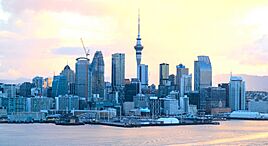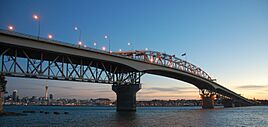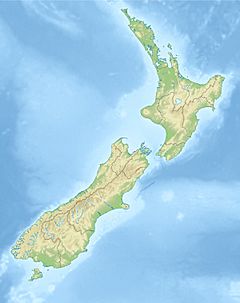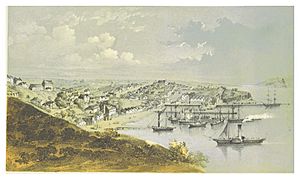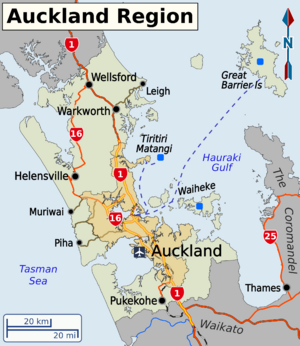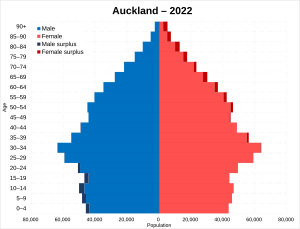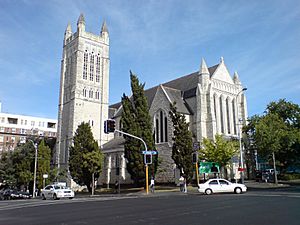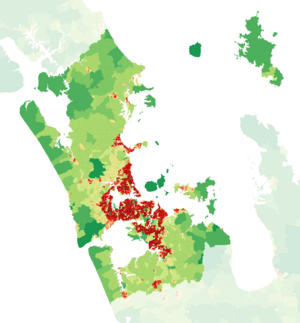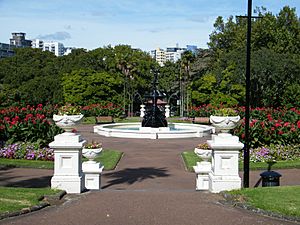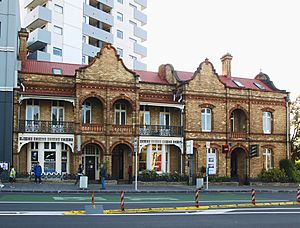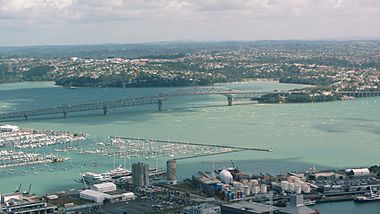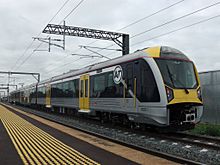Auckland facts for kids
Quick facts for kids
Auckland
Tāmaki Makaurau (Māori)
|
|
|---|---|
|
Metropolitan city
|
|
| Nicknames:
City of Sails
Queen City |
|
| Country | New Zealand |
| Island | North Island |
| Region | Auckland |
| Settled by Māori | c. 1350 |
| Settled by Europeans | 1840 |
| Named for | George Eden, 1st Earl of Auckland |
| NZ Parliament |
Electorates
Auckland Central |
| Local boards |
List
Hibiscus and Bays
Upper Harbour Kaipātiki Devonport-Takapuna Waitākere Ranges Henderson-Massey Whau Albert-Eden Puketāpapa Waitematā Ōrākei Maungakiekie-Tamaki Māngere-Ōtāhuhu Otara-Papatoetoe Howick Manurewa Papakura Franklin Rodney |
| Government | |
| • Body | Auckland Council |
| Area | |
| • Urban | 605.67 km2 (233.85 sq mi) |
| Highest elevation | 196 m (643 ft) |
| Lowest elevation | 0 m (0 ft) |
| Population
(June 2023)
|
|
| • Urban | 1,478,800 |
| • Urban density | 2,441.59/km2 (6,323.70/sq mi) |
| • Auckland Region | 1,739,300 |
| • Demonym | Aucklander Jafa (pejorative) |
| GDP | |
| • Auckland Region | NZ$ 139.5 billion (2022) |
| • Per capita | NZ$ 80,300 (2022) |
| Time zone | UTC+12:00 (NZST) |
| • Summer (DST) | UTC+13:00 (NZDT) |
| Postcode(s) |
0600–2699
|
| Area code(s) | 09 |
| Local iwi | Ngāti Whātua, Tainui, Ngāti Ākarana (pan-tribal) |
Auckland (pronounced AWK-lənd) is a very large city in the North Island of New Zealand. It's the biggest city in New Zealand and the fifth largest in Oceania. Auckland is also known as the "City of Sails" because so many people enjoy sailing there.
The city is home to about 1.4 million people. It's a very diverse place, with people from many different backgrounds. A large number of Auckland residents were born overseas, making it one of the most multicultural cities in the world. It also has the largest Polynesian population of any city. The Māori name for Auckland is Tāmaki Makaurau, which means "Tāmaki desired by many." This name refers to how rich the area's natural resources were.
Auckland is surrounded by water and hills. To the east is the Hauraki Gulf, and to the west are the Waitākere Ranges. The city sits on a narrow strip of land between two harbours: the Manukau Harbour on the Tasman Sea and the Waitematā Harbour on the Pacific Ocean. This makes Auckland one of the few cities in the world with harbours on two different major bodies of water. The area also has 53 volcanoes, though they are not active now.
Māori people first settled the Auckland area around 1350, valuing its rich land. When Europeans arrived in 1840, Auckland was chosen as New Zealand's capital. It was named after George Eden, Earl of Auckland. Even though it stopped being the capital in 1865, Auckland continued to grow. Today, Auckland is New Zealand's main economic centre. It's also known as one of the world's most liveable cities.
Contents
- Auckland's Past: A Look at History
- Auckland's Location and Landscape
- Auckland's People and Culture
- Auckland's Culture and Fun Activities
- Buildings and Design in Auckland
- Auckland's Economy
- Homes in Auckland
- Learning in Auckland: Education
- Getting Around Auckland: Transport
- City Services and Utilities
- Notable People from Auckland
- Auckland's International Connections
- See also
Auckland's Past: A Look at History
Early Days: Māori Settlement and European Arrival

Māori people settled the Auckland isthmus around 1350. They loved the land because it was very rich and fertile. Many pā (fortified villages) were built on the volcanic hills. By the early 1700s, the Te Waiohua tribes were powerful in the area.
Around 1740, the Ngāti Whātua tribe became the main group on the Auckland isthmus. Before Europeans arrived, about 20,000 Māori lived here. Later, the arrival of guns led to wars between tribes, causing many Māori to move away. So, when Europeans started settling, there were fewer Māori in the area.
In 1840, a Māori chief named Apihai Te Kawau signed the Treaty of Waitangi. The Ngāti Whātua tribe then gave land to the new Governor of New Zealand, William Hobson, for a new capital city. Hobson named it Auckland after George Eden, Earl of Auckland. Auckland officially became New Zealand's capital in 1841. However, in 1865, Wellington became the capital instead because it was more central.
Auckland's Growth and Modern Times
In the mid-1800s, the government encouraged British soldiers and their families to move to Auckland. They helped defend the city and built roads. This helped Auckland grow quickly. By 1864, the population was over 12,000 people.
In the early 1900s, trams and trains helped Auckland expand. But after World War II, cars became more popular. New motorways were built, which helped the city spread out into new suburbs like the North Shore and Manukau City.
In the 1980s, New Zealand's economy changed a lot. Many companies moved their main offices to Auckland, making it the country's economic heart. Tourism also grew, with many international visitors arriving through Auckland Airport.
A big change came in 1986 when the government allowed more immigrants from Asia. This made Auckland a truly multicultural city. By 2006, a large part of Auckland's population was Asian. Newcomers brought different cultures, foods, and religions, making Auckland a very diverse place to live.
Auckland's Location and Landscape
Where is Auckland?
Auckland's exact borders can be a bit tricky to define. The main urban area covers about 607 square kilometers. It stretches from Long Bay in the north to Runciman in the south.
The wider Auckland Region includes the city centre, suburbs, nearby towns, islands, and rural areas. This whole region is managed by the Auckland Council.
The busiest part of Auckland is the Auckland central business district (CBD). It's a triangular area right by the Waitematā Harbour.
Harbours and Islands
Auckland sits on a narrow strip of land, less than two kilometers wide at its thinnest point. This land is between the Manukau Harbour to the south and the Waitematā Harbour to the north. The Waitematā Harbour connects to the Pacific Ocean through the Hauraki Gulf.
Bridges cross parts of both harbours. The most famous is the Auckland Harbour Bridge, which connects the city centre to the North Shore. In the past, Māori used to carry their canoes across the narrowest parts of the land between the harbours.
Many islands in the Hauraki Gulf are part of the Auckland Region. Some, like Waiheke Island, are like suburbs. Others are nature reserves, home to special plants and animals.
Auckland's Climate
Auckland has a mild climate with warm summers and gentle winters. It's one of the warmest main cities in New Zealand. The average high temperature is around 24°C in February (summer) and 15°C in July (winter).
Snow is very rare in Auckland. The last time it snowed significantly was in 1939. Frosts also don't happen very often. The sea temperature around Auckland is warmest in February, averaging about 21°C.
Winds mostly come from the southwest. In summer, there's often a sea breeze that starts in the morning. Fog is common, especially in autumn and winter.
Volcanoes of Auckland

Auckland is built on top of the Auckland Volcanic Field. This area has had at least 53 small volcanoes erupt over the last 193,000 years. These eruptions created different landforms like craters, tuff rings, and hills made of volcanic rock. Each volcano usually erupts only once.
The most recent eruption happened around 1450 AD, forming Rangitoto Island. Māori people living in the area saw this eruption. Scientists believe future eruptions will happen at a new, unknown spot within the field.
These volcanoes have been very important for Auckland. In the past, Māori used the volcanic hills (called maunga) as fortified villages (pā) because they were high up and easy to defend. The rich volcanic soil was also great for growing crops like kūmara (sweet potato).
After Europeans arrived, many volcanic hills were used as quarries to get building materials for the growing city. Because of this, some were badly damaged or even destroyed. Today, most of the remaining volcanic hills are protected as parks.
Auckland's People and Culture
Who Lives in Auckland?
Auckland is New Zealand's largest urban area, with an estimated population of about 1.4 million people. This means Auckland has more people than the entire South Island of New Zealand!
In the 2023 census, Auckland's population grew by over 56,000 people since 2018. The city is home to many different age groups, with a median age of 35.1 years.
A Multicultural City
Auckland is famous for being a very cosmopolitan (multicultural) city. While most people used to be of European background, this has changed a lot. Now, people of Asian descent make up almost one-third of the population. Auckland also has the largest Polynesian population of any city in the world.
In the 2023 census, people could choose more than one ethnic group. The results showed:
- 44.0% European (Pākehā)
- 12.2% Māori
- 18.7% Pasifika (Pacific Islanders)
- 34.9% Asian
- 2.9% Middle Eastern, Latin American, and African (MELAA)
- 1.7% other groups
English is spoken by most people (91.5%). Other languages spoken include Māori (2.7%) and Samoan (5.3%). A large number of people (44.9%) living in Auckland were born overseas. This makes Auckland one of the cities with the most foreign-born residents in the world.
Religious Beliefs
Auckland has many different religions. In the 2023 census, 35.7% of people identified as Christian. Other religions include Hindu (6.1%), Islam (3.3%), Buddhist (2.1%), and Māori religious beliefs (0.9%). A large number of people (42.7%) said they had no religion.
Because many people have moved to Auckland from Asia, the city has seen an increase in people following Buddhism, Hinduism, Islam, and Sikhism.
Future Growth of Auckland
Auckland's population is growing quickly, mostly because people are moving there from other countries. Experts think the population could reach 1.9 million by 2031. This growth means the city needs more homes and better transport.
To help with housing, the Auckland Council created a plan in 2016. This plan aims to make more land available for building and to build more homes in existing urban areas. The goal is to create 422,000 new homes in the next 30 years.
Auckland's Culture and Fun Activities
Things to Do for Fun
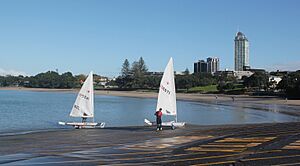
Auckland is often called the "City of Sails" because sailing is so popular here. Many people in Auckland own boats, and the city has hosted the famous America's Cup sailing race three times.
The Waitematā Harbour has many yacht clubs and marinas, including Westhaven Marina, which is the largest in the Southern Hemisphere. There are also several swimming beaches along the harbour, like Mission Bay and Kohimarama.
On the west coast, you'll find popular surf beaches such as Piha and Muriwai. Many of these beaches have surf lifesaving clubs that help keep swimmers safe.
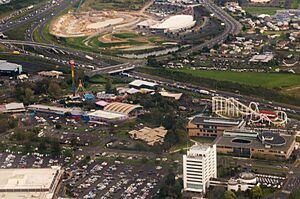
Auckland has many great places to shop, including Queen Street, Britomart, and Newmarket. There are also large shopping centres like Sylvia Park and Westfield Albany. For unique finds, you can visit weekend markets in places like Ōtara and Avondale.
Arts and Museums
Auckland hosts many art and cultural events, such as the Auckland Festival and the New Zealand International Film Festival. The Auckland Philharmonia is the city's main orchestra.
Events celebrating Auckland's diverse cultures include the Pasifika Festival, Polyfest, and the Auckland Lantern Festival. These are the biggest of their kind in New Zealand. Auckland is also recognized by UNESCO for its music scene.
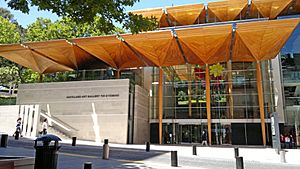
Important museums and galleries include the Auckland Art Gallery, the Auckland War Memorial Museum, and the Museum of Transport and Technology (MOTAT). The Auckland Art Gallery is the largest gallery in New Zealand, with over 17,000 artworks.
Parks and Nature Spots
Auckland Domain is one of the city's biggest parks, offering great views of the Hauraki Gulf and Rangitoto Island. Other parks near the city centre include Albert Park and Victoria Park.
Many of Auckland's volcanic cones are now parks, like Maungawhau / Mount Eden and Maungakiekie / One Tree Hill. These parks have ancient earthworks and old fortifications.
You can take ferries to visit parks and nature reserves on islands like Waiheke Island and Rangitoto Island. To the west and south of Auckland, the Waitākere Ranges and Hunua Ranges offer beautiful natural bush areas.
Sports in Auckland
Rugby union, cricket, rugby league, football (soccer), and netball are very popular sports in Auckland. The city has many stadiums and venues for different sports.
Main Sports Venues
- Eden Park is the biggest stadium, used for international rugby and cricket games. It's home to the Blues rugby team.
- Mt Smart Stadium is used for rugby league and football. It's the home ground for the New Zealand Warriors rugby league team and Auckland FC football team.
- North Harbour Stadium hosts rugby and football games, and concerts.
- ASB Tennis Centre is where international tennis tournaments are held each January.
- Spark Arena is an indoor stadium mainly for concerts and is home to the New Zealand Breakers basketball team.
- Trusts Arena is an indoor venue for netball, home to the Northern Mystics.
Major Sports Teams
- Rugby Union: The Blues play in Super Rugby. Auckland also has three teams in the Mitre 10 Cup: Auckland, North Harbour, and Counties Manukau.
- Rugby League: The New Zealand Warriors play in Australia's National Rugby League.
- Cricket: The Auckland Aces (men's) and Auckland Hearts (women's) play at Eden Park.
- Football (Soccer): Auckland FC plays in the A-League Men.
- Netball: The Northern Mystics and Northern Stars play in the ANZ Premiership.
- Basketball: The New Zealand Breakers play in the Australian National Basketball League.
Big Sporting Events
- The ATP Auckland Open and WTA Auckland Open are tennis tournaments held every January.
- The Auckland Marathon is a big annual running event with thousands of participants.
- The Auckland Anniversary Regatta is a sailing race held every year since 1840. It's the oldest sporting event in New Zealand.
- The Auckland Harbour Crossing Swim is a swimming event across the Waitematā Harbour.
- Round the Bays is a popular fun-run along the Auckland waterfront.
Buildings and Design in Auckland
Auckland has many different building styles, from early settlement homes to modern skyscrapers. The city works to protect its historic buildings. Important old buildings include the Dilworth Building, the Auckland Ferry Terminal, Landmark House, and the Auckland Town Hall. Many of these are on Queen Street, a main road.
Auckland's Economy
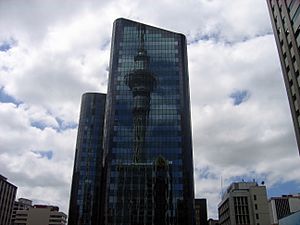
Auckland is the main economic and financial hub of New Zealand. It has a strong economy with a focus on finance, business, and tourism. Most big international companies have offices in Auckland. The most expensive office spaces are around Queen Street and the Viaduct Basin in the Auckland CBD.
The biggest business and industrial areas are the Auckland CBD and parts of Manukau. Auckland is considered a "Beta + World City" because it's important for business, arts, and education.
Many people in Auckland work in professional services, manufacturing, retail, healthcare, and education. Manufacturing is a big employer in some southern and eastern parts of the city.
The Auckland region's economy was worth about NZ$143 billion in 2023. This is almost 40% of New Zealand's total economy! The average income per person in Auckland is also high.
Homes in Auckland
Homes in Auckland vary a lot. Some areas have government-owned housing for lower-income families, while others have very fancy homes by the water. Traditionally, most Aucklanders lived in a single house on a large piece of land. However, many of these properties have been divided to build more homes.
Auckland's housing has become more diverse, with many apartments built, especially in the city centre. Still, most Aucklanders live in single houses.
Auckland's housing is very expensive compared to average incomes. House prices have gone up much faster than inflation in recent years. In August 2022, the average house price in Auckland was $1,100,000. This is much higher than the average price outside Auckland. There are many discussions about why housing is so expensive, including a lack of available land and high demand.
Some older Victorian houses have been torn down for new buildings. However, there are efforts to protect the city's heritage, as Auckland has many beautiful old wooden houses.
Housing Challenges
Auckland has faced a housing challenge, with not enough affordable homes for everyone. To help, a law was passed in 2013 to make sure a certain percentage of new homes are affordable. For example, in one new area, 20% of homes were sold for under $550,000.
The population growth, especially from people moving to Auckland, has added to the demand for housing. However, house prices have started to fall recently due to inflation and higher interest rates.
Learning in Auckland: Education
Schools for Kids and Teens
Auckland has many schools: 340 primary schools, 80 secondary schools, and 29 schools that combine primary and secondary levels. These schools teach almost a quarter of a million students. Most are state schools, but some are state-integrated or private.
Some of the largest schools in New Zealand are in Auckland, like Mt Albert Grammar School and Rangitoto College, which has over 3,000 students.
Universities and Colleges
Auckland is a big centre for higher education. Five of New Zealand's eight universities have campuses here, along with many polytechnics (technical colleges). The main universities based in Auckland are the University of Auckland and Auckland University of Technology.
Many international students come to Auckland to learn English or study at universities.
Getting Around Auckland: Transport
Roads and Trains
Auckland has a network of highways that connect different parts of the city. State Highway 1 is the main road running north to south. The Northern Busway is a special lane for buses on the North Shore.
The Auckland Harbour Bridge, opened in 1959, is the main link between the North Shore and the rest of Auckland. It has eight lanes for cars but no paths for walking or cycling. The Central Motorway Junction, also called 'Spaghetti Junction', is a complex intersection of major motorways.
Auckland has four main railway lines. These lines connect the western, southern, and eastern parts of the city to the Waitematā railway station downtown. This station also connects to ferry and bus services. A big project called the City Rail Link is building an underground rail tunnel to improve train travel. There are also plans for a new light rail network.
How People Travel
Most people in Auckland use private cars to get around. Only a small percentage use buses, trains, or ferries for their daily journeys. This means there's often a lot of traffic during busy times.
Bus services mostly go from the suburbs to the city centre. There are not many bus routes that go across town. Late-night bus services are also limited. However, bus services have been improved recently to offer more frequent routes.
Train services connect the city centre to the west, south, and south-east. Auckland's rail network has been upgraded with new electric trains.
Other Ways to Travel
Auckland's ports are very important for trade in New Zealand. Most goods coming into or leaving the country pass through these ports. Auckland is also a major stop for cruise ships. Ferries connect the city centre to coastal suburbs, the North Shore, and nearby islands.

Air Travel
Auckland Airport is the busiest airport in New Zealand. It's located in the southern suburb of Māngere. There are many flights to Australia and other parts of New Zealand. You can also fly directly to places in the South Pacific, the United States, China, Asia, and other international cities.
City Services and Utilities
Electricity for Auckland
Most of Auckland's electricity network is managed by a company called Vector. Electricity comes from the national grid through many substations. Since there are no major power stations in Auckland or to its north, most of the electricity comes from power stations further south.
Auckland has had some big power outages in the past. In 1998, a large part of the city centre lost power for five weeks. In 2006, another blackout affected the city centre and inner suburbs. Since then, a lot of money has been spent to make the electricity supply to Auckland more reliable.
Natural Gas Supply
Auckland was one of the first cities in New Zealand to get natural gas. This happened in 1970 when a long pipeline was built from a gas field in Taranaki. Later, Auckland was connected to another gas field called Maui.
Notable People from Auckland
Auckland's International Connections
Auckland has special relationships with other cities and countries around the world. These are called "sister city" relationships or "friendship and cooperation" agreements.
Sister Cities
- Los Angeles, United States (1971)
- Utsunomiya, Japan (1982)
- Fukuoka, Japan (1986)
- Brisbane, Australia (1988)
- Guangzhou, China (1989)
- Kakogawa, Japan (1992)
- Busan, South Korea (1996)
- Taichung, Taiwan (1996)
- Ningbo, China (1998)
- Qingdao, China (2008)
Friendship and Cooperation Cities
- Tomioka, Japan (1983)
- Shinagawa, Japan (1993)
- Galway, Ireland (2002)
- Nadi, Fiji (2006)
- Hamburg, Germany (2007)
- Pohang, South Korea (2008)
- Shanghai, China (2012)
Cooperation Countries
- Cook Islands (2012)
- Samoa (2012)
- Tonga (2012)
See also
 In Spanish: Auckland para niños
In Spanish: Auckland para niños


